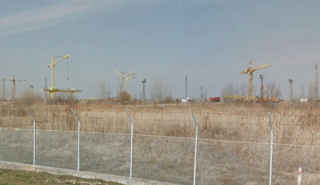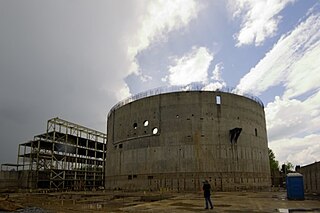
The Hanford Site is a decommissioned nuclear production complex operated by the United States federal government on the Columbia River in Benton County in the U.S. state of Washington. It has also been known as Site W and the Hanford Nuclear Reservation. Established in 1943 as part of the Manhattan Project, the site was home to the Hanford Engineer Works and B Reactor, the first full-scale plutonium production reactor in the world. Plutonium manufactured at the site was used in the first atomic bomb, which was tested in the Trinity nuclear test, and in the Fat Man bomb used in the bombing of Nagasaki.

Satsop is a census-designated place (CDP) in Grays Harbor County, Washington, United States. The population was 675 at the 2010 census, up from 619 at the 2000 census.

The Bellefonte Nuclear Generating Station (BLN) is an unfinished nuclear power plant in Hollywood, Alabama, United States.

Columbia Generating Station is a nuclear commercial energy facility located on the Hanford Site, 10 miles (16 km) north of Richland, Washington. It is owned and operated by Energy Northwest, a Washington state, not-for-profit joint operating agency. Licensed by the Nuclear Regulatory Commission in 1983, Columbia first produced electricity in May 1984, and entered commercial operation in December 1984.

The South Texas Project Electric Generating Station, is a nuclear power station southwest of Bay City, Texas, United States. STP occupies a 12,200-acre (4,900 ha) site west of the Colorado River about 90 miles (140 km) southwest of Houston. It consists of two Westinghouse Pressurized Water Reactors and is cooled by a 7,000-acre (2,800 ha) reservoir, which eliminates the need for cooling towers.

The N-Reactor was a water/graphite-moderated nuclear reactor constructed during the Cold War and operated by the U.S. government at the Hanford Site in Washington; it began production in 1963.

The Lungmen Nuclear Power Plant, formerly known as Gongliao and commonly as the Fourth Nuclear Power Plant, is an unfinished nuclear power plant in New Taipei City, Taiwan. It consists of two ABWRs each of 1,300 MWe net. It is owned by Taiwan Power Company (Taipower).

Nuclear power in the United States is provided by 92 commercial reactors with a net capacity of 94.7 gigawatts (GW), with 61 pressurized water reactors and 31 boiling water reactors. In 2019, they produced a total of 809.41 terawatt-hours of electricity, which accounted for 20% of the nation's total electric energy generation. In 2018, nuclear comprised nearly 50 percent of US emission-free energy generation.

Heysham nuclear power station is operated by EDF Energy in Heysham, Lancashire, England. The site is divided into two separately-managed nuclear power stations, Heysham 1 and Heysham 2, both with two reactors of the advanced gas-cooled reactor (AGR) type.
Energy Northwest is a public power joint operating agency in the northwest United States, formed 66 years ago in 1957 by Washington state law to produce at-cost power for Northwest utilities. Headquartered in the Tri-Cities at Richland, Washington, the WPPSS became commonly known as "Whoops!", due to over-commitment to nuclear power in the 1970s which brought about financial collapse and the second largest municipal bond default in U.S. history. WPPSS was renamed Energy Northwest in November 1998, and agency membership includes 28 public power utilities, including 23 of the state's 29 public utility districts.

The Belene Nuclear Power Plant is a planned nuclear power plant 3 km from Belene and 11 km from Svishtov in Pleven Province, northern Bulgaria, near the Danube River. It was intended to substitute four VVER-440 V230 reactors of the Kozloduy Nuclear Power Plant that were decommissioned as a prerequisite for Bulgaria to join the European Union.

The Żarnowiec Nuclear Power Plant was to be the first nuclear power plant in Poland. The construction was cancelled due to changes in the economic and political situation in Poland, in the Soviet Union and in the Eastern Bloc and due to the Chernobyl disaster in 1986 and the following years. It was to be located in the former village of Kartoszyno and had its seat in Nadole.

The Cherokee Nuclear Power Plant is an uncompleted energy project 10 miles (16 km) outside Gaffney, South Carolina, United States. In the early 1970s, Duke Power started construction on a three-reactor nuclear power plant at the site. However, the project stalled due to economic problems by the early 1980s, leading to the project's eventual abandonment. In 1987, the power plant was the site of an underwater film studio built by Hollywood director James Cameron, for the film The Abyss.
In 2008, nuclear energy provided Switzerland with 40 percent of its electricity, but a survey of Swiss people found that only seven percent of respondents were totally in favor of energy production by nuclear power stations. Many large anti-nuclear demonstrations and protests have occurred over the years.

Washington Nuclear Project Nos. 1 and 4, abbreviated as WNP-1 and WNP-4 were two of the five nuclear power plants on which construction was started by the Washington Public Power Supply System (WPPSS) in order to meet projected electricity demand in the Pacific Northwest. WNP-1, WNP-2 and WNP-3 were part of the original 1968 plan, with WNP-4 and WNP-5 added in the early 1970s.
X-energy is an American private nuclear reactor and fuel design engineering company. It is developing a Generation IV high-temperature gas-cooled pebble-bed nuclear reactor design. Since its founding in 2009, it has received various government grants and contracts, notably through the Department of Energy's (DOE) Advanced Reactor Concept Cooperative Agreement in 2016 and its Advanced Reactor Demonstration Program (ARDP) in 2020.

Robert Louis (Bob) Ferguson was a nuclear-trained physicist and a 60-year veteran in the field of nuclear energy. He was best known for being appointed the first Deputy Assistant Secretary for Nuclear Energy Programs for the U.S. Department of Energy (DOE) by the first Energy Secretary, James Schlesinger, serving from 1978 to 1980 during President Jimmy Carter's administration.

The Northwest Cannabis Solutions Satsop facility is a 50,000-square-foot (4,600 m2) indoor cannabis growing facility at the Satsop Business Park in Satsop, Washington occupied by Northwest Cannabis Solutions, the largest I-502 legal cannabis grower in the State of Washington. The two-story facility was built in 1980 as part of the canceled Satsop Nuclear Power Plant complex built by WPPSS, also called "Whoops!", and was leased from the new owner, Port of Grays Harbor by Northwest Cannabis in October 2016. When the company was preparing to move in, in late 2016–early 2017, three new transformers were installed to furnish 9,000 amps for 2,000 grow lights and a robust HVAC plant. Over six million dollars in improvements were made by the lessee, who executed a five-year lease with options to extend 45 more years.

The Electric Bond and Share Company (Ebasco) was a United States electric utility holding company organized by General Electric. It was forced to divest its holding companies and reorganize due to the passage of the Public Utility Holding Company Act of 1935. Following the passage of the Act, the U.S. Securities and Exchange Commission (SEC) selected the largest of the U.S. holding companies, Ebasco to be the test case of the law before the U.S. Supreme Court. The court case known as Securities and Exchange Commission v. Electric Bond and Share company was settled in favor of the SEC on March 28, 1938. It took twenty-five years of legal action by the SEC to break up Ebasco and the other major U.S. electric holding companies until they conformed with the 1935 act. It was allowed to retain control of its foreign electric power holding company known as the American & Foreign Power Company (A&FP). After its reorganization, it became an investment company, but soon turned into a major designer and engineer of both fossil fuel and nuclear power electric generation facilities. Its involvement in the 1983 financial collapse of the Washington Public Power Supply System's five nuclear reactors led to Ebasco's demise because of the suspension of nuclear power orders and lawsuits that included numerous asbestos claims. The U.S. nuclear industry stopped all construction of new facilities following the 1979 nuclear meltdown at Three Mile Island, going into decline because of radiation safety concerns and major construction cost overruns.

















